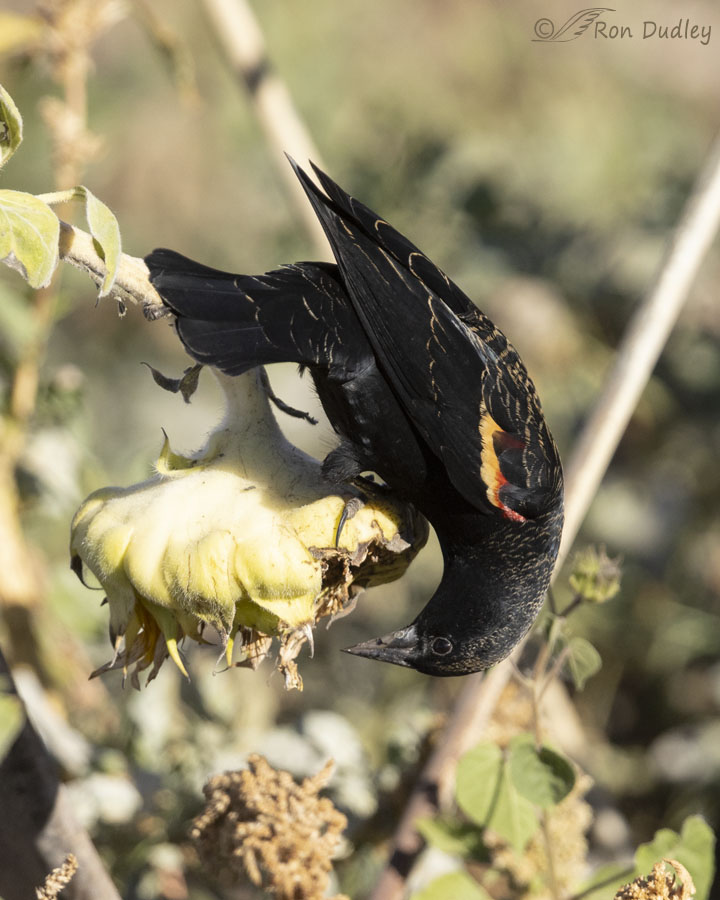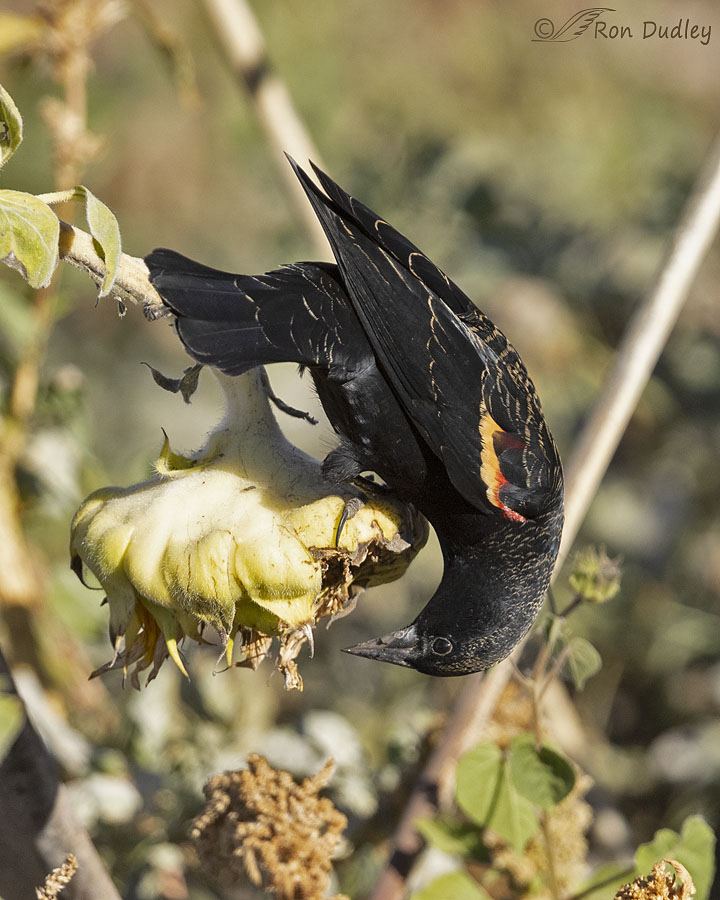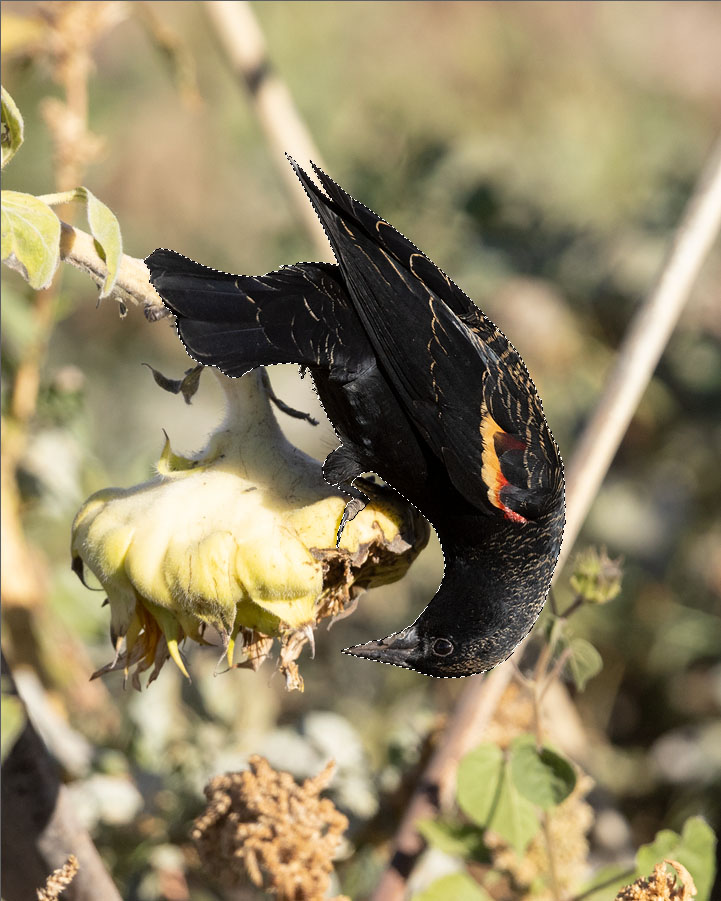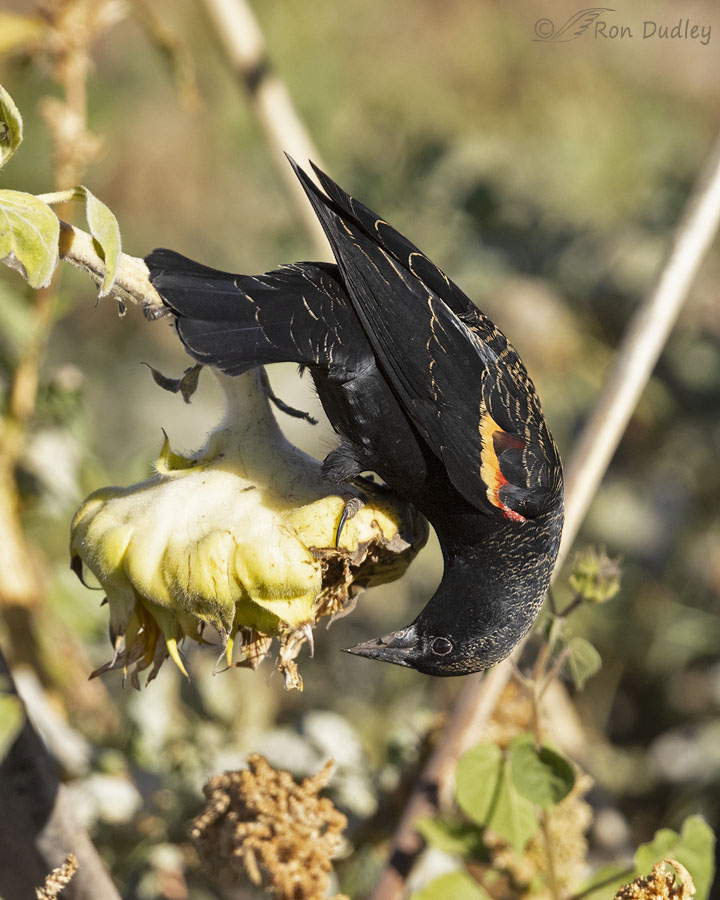One way to prevent/reduce sharpening halos during processing.
Warning – today’s post is unusually heavy on “photogeek” so it won’t be for everyone.
Two days ago I spent some time photographing Red-winged Blackbirds feeding on sunflowers near Farmington Bay WMA. The sunflowers were past their prime and somewhat sun-bleached and of course the blackbirds were… well, mostly black, so most of my photos were high contrast, resulting in very difficult exposures.

But I thought this one had potential.
This is an unprocessed version of the image – at this point all I’ve done to it is crop and resize the photo. As is, I don’t like the photo much because for my tastes some of the blacks of the bird are too dark with little detail, the highlights are too bright (especially the sunflower head) and the bird could use some sharpening (virtually all photos taken in RAW need at least some sharpening).
With many photos those adjustments can be made quickly and globally (globally = applied to the entire image) without any problems but in a high-contrast image like this one, sharpening globally and even using the Shadows/Highlights Tool can cause distracting halos to appear at sharp, high-contrast edges.

In this version of the image I’ve sharpened the photo and increased exposure in the blacks and decreased exposure of the highlights using the Shadows/Highlights Tool in Photoshop – all adjustments done globally.
However, an annoying and distracting sharpening halo has appeared, especially at the wingtips because the wingtips are so high contrast against the very bright stem behind them. If you look carefully (it’s fairly subtle and probably harder to see on small screens, especially phones) you’ll see the halo as a narrow and very bright edge along some of the margins of the wingtips. When I spot an obvious halo in one of my photos I find it so distracting it detracts from my appreciation of the image, no matter how good it might otherwise be.
There’s more than one way to prevent or reduce sharpening halos but as far as I know they all involve extra work during processing. Here’s the method I use.

I build a carefully constructed sharpening mask around the bird only, so that sharpening (and in this case the effects of the Shadows/Highlights Tool) are applied selectively to the bird only. Here the mask can be seen as what some folks call “marching ants” around the edges of the bird. In Photoshop the “ants” are actually moving so they’re more easily seen, but here they’re static.

1/2500, f/6.3, ISO 800, Canon R5, Canon EF500mm f/4L IS II USM + 1.4 tc, not baited, set up or called in
Here’s the final version of the photo. The bird has been sharpened, there’s more detail in some of the blacks, the highlights aren’t quite so bright and most importantly – that annoying halo at the wingtips is drastically reduced to the point of not being an issue. Now I can enjoy the image for what it is, rather than being distracted by that damn halo.
Yeah, it’s a busy setting but I like the behavior, his upside-down posture and I think his twisted tail is… cute.
Ron
Note: I’m far from an expert on processing in Photoshop and as I said earlier, there are other methods of preventing or reducing sharpening halos. Some of them may be better than this one but it’s the one I use when I need to.


I really appreciated today’s “photo-geek” post on reducing sharpening halos.
They bug me big time as well. Here is what I do: First, I blow up the image to 200%
Then I do is use the clone stamp and select just below the halo, then go over the halo with the clone stamp to reduce it’s appearance.
I am not as good as creating a sharpening mask as you are. Did you use “object select tool” to create your mask?
Great blog!
“Did you use “object select tool” to create your mask?”
No I didn’t, Rene. I generally shy away from that tool because it often isn’t very precise in constructing the mask. But the edges of this bird are distinct enough that it might have worked pretty well. I just didn’t think to try it.
I learn a lot with your “techno-geek” blogs concerning settings and editing.
Hope you are recovering well
Take Care!
I enjoyed this. But I have a question.
How many pain meds are you on? CUTE?
LOLOLOL
Good one, Arwen. It’s so out of character Mr. FP.
Ha, I figured someone would call me out on that one, Arwen! Thanks for the laugh.
And the answer to your question is none.
I almost always learn from you – though some of the things I learn I will never use (and sadly as a consequence quickly forget).
And I am awed at the work that goes into bringing your images to us.
Thank you.
And echoing Marty about the arc of the photo.
EC, I usually don’t go to this much work for the images I post. This one just happened to need it
So glad you’re back to posting, Ron.
Cathryn
Thanks, Cathryn. It’ll only be intermittent at best,
Love the “Photo Geek” stuff, Ron! I am always happy to learn new tricks. And I love the photo – busy background and all! Thanks for the info.
Thank you, Joanne.
I can’t really see the halo even on my big screen. I have Photoshop, it comes in the monthly subscription with Lightroom. I hate editing and Photoshop takes more time than I am willing to expend, so I use just the basic tools to adjust in Lightroom. I took a class through Adult Ed at the U, it was well taught and I learned a lot but not practicing using Photoshop in the 4 years since, most of my knowledge of the system is gone.
April, I guess when a halo can’t be seen it isn’t a problem.
Very interesting blog this am from the shot to your processing description. Bluebirds here are hanging upside down to get peanuts from the feeder. SO entertaining.
Sounds like you need to aim a lens at your bluebirds, Kathleen.
Interesting info about PS. I don’t know if I’ve heard the term, “Marching ants,” before, but it is certainly an apt description. I really like the arc the blackbird forms around the sunflower head.
Thanks, Marty. “Marching ants” is a darn good descriptor of what it looks like.
My largest screen is my laptop, so I had to zoom in quite a bit to see what is probably readily apparent on your monitor. The halo is very apparent around a lot of the Blackbird. I suspect most of your readers would not be aware of the subtle imperfections you see, but nevertheless are unsuspecting beneficiaries of your post-process improvements. Most of all, though, your skill with the camera, knack for catching birds and such at captivating moments, and your way with words, whether explaining your technical processes, shooting situations, or any other subject, are the real attraction.
And, seeing that you’re out and about, and not that you need to be reminded, to paraphrase Seinfeld’s soup nazi, “No BLT for you.”
Thanks very much, Lyle.
Halos are inherent with digital photography, even before sharpening, but they’re a matter of degree. They only become a problem when processing exaggerates them to the point that they’re apparent and distracting.
Very interesting Ron. I don’t have Photoshop so not familiar with the world of high tech processing that very serious amateur and professional photographers use. Thanks for the demo.
Glad you found it interesting, Everett.
Terrific photo, Ron and really great tutorial. I’ve never been able to get Photoshop to work for me and as such have had to restrict my LR only edited photo sharing to easy-to-please friends and family but I really appreciate the difference when someone who can use it is able to bring out the detail as you have done here and eliminate those annoying artifacts. Thanks for sharing the process.
Much appreciated, Granny Pat. I had one-on-one help when I was learning PS and that made a big difference.
I hear you about that one on one help. I guess I’m of the old school that really needs a human teacher/tutor and at least some amount of individual attention before unfurling my wings.
I love the arc of the bird’s posture, and am so impressed to see the detail
of the markings within the mostly black plumage– never would have imagined
there was so much else going on, visually. Don’t apologize for “geekiness”–
any day that Feathered Photography shows up in my e-mail dock, I know
my day will start out with something interesting AND beautiful.
I’m glad you enjoyed the geekiness, Kris. I doubt everyone will.
Interesting! It DOES make a difference. Does your essential tremor cause problems with outlining the bird?
“Does your essential tremor cause problems with outlining the bird?”
Not really, Judy. I use the mouse to do it and the mouse keeps my hand pretty stable. My hands are actually pretty stable most of the time, but when I get tense, nervous or excited about something the tremor can become a problem.
I never, ever eat soup in public unless I want to bathe in it.
I don’t have the tremor but do have trouble “outlining” in Photoshop Elements – of course, haven’t practiced a lot either!
I have both PS and Elements. PS has more sophisticated tools for a lot of processing tasks, including masking.
You are a perfectionist. I’m having trouble seeing the halo effect. Probably more to do with my laptop screen resolution.
Thanks for another tutorial. I find them interesting.
Michael, I suspect the halo is more difficult to see on smaller screens, especially phones.
Terrific photo Ron. A really interesting and fun capture. I’m not sure how he doesn’t flip tail feathers over tea kettle!
So happy you’re able to get out and do some careful shooting. Hope your healing and recovery keep moving forward as best as possible.
Thanks very much, Mark.